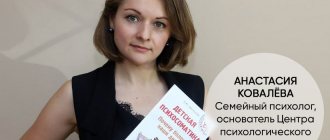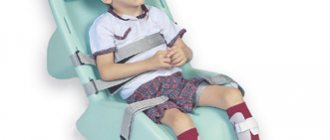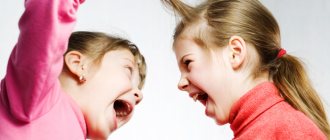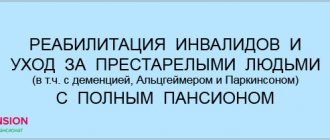October 02, 2021
There are several classifications of cerebral palsy. They take into account the characteristics and level of severity of the disease. The gradation of forms of cerebral palsy is based on such manifestations of the disease as the location of limb lesions, the age at which diagnosis is made, the degree of impairment of motor coordination and intellectual abilities of the child.
Some types of cerebral palsy can be identified already in the first months of a child’s life. Others are diagnosed a little later, towards the beginning of the second year. The forms of cerebral palsy depend on the affected areas of the brain and are determined by their characteristic features.
Spastic diplegia
This is the most common of all types of cerebral palsy disorders; this form of the disease is diagnosed in ¾ of cases. Causes of pathology include premature birth, low birth weight or birth trauma. The diagnosis is most often made in the first six months of a child’s life.
Characteristic signs of this form of the disease include:
- spastic tetraparesis with damage to the lower extremities;
- delayed development of the motor sphere;
- characteristic gait - hips turned inward, knees connected;
- oculomotor disorders – strabismus, decreased visual acuity;
- hearing impairment;
- delayed speech development is observed in 80% of patients.
Mental development in this form of cerebral palsy suffers less than in other cases. Oligophrenia occurs in 20% of children with spastic diplegia.
Treatment includes drug therapy, physical therapy, massage, sessions with a psychologist and speech pathologist for delayed speech development (dysarthria).
The prognosis in the motor sphere is not very favorable. Only every fourth patient can move independently, and with severe tetraparesis the patient is forced to be in a wheelchair. While maintaining mental abilities, patients can study along with healthy children.
Cerebral palsy, atonic-astatic form: treatment
An obligatory part of the treatment is the effect on the muscles. We are talking about classic and acupressure massage. Some children are prescribed acupuncture. Physical therapy has a beneficial effect on the patient’s condition if he is able to move independently.
Drug treatment is used. Children are prescribed medications that improve muscle condition, increase their tone, and eliminate cramps, if any. Some specialists resort to hippotherapy. Horseback riding has a positive effect on muscles and on keeping the body in balance.
Metameric treatment methods have proven their effectiveness. Metameric technologies are based on a combination of acupuncture of gradient zones (zones of maximum biological activity) of the affected metamer with the simultaneous administration of drugs that have neuroprotective and neuroregenerative effects.
The effect of treatment is enhanced by metameric massage, the essence of which is to influence certain areas of the body. Metameric therapy is developed strictly individually for each patient. An individual approach is the key to success in this case.
With the right approach to diagnosis and therapy, the negative impact of the disease on the child can be reduced. The main thing is to detect the disease in time and contact a specialist without delay. In order not to waste precious time, it is recommended to undergo preventive examinations with a pediatric neurologist.
Hemiplegia
With this form of cerebral palsy, half the body is affected. In terms of prevalence, this form of the disease is second only to spastic diplegia. Most often it is diagnosed in premature infants or in children who have suffered intracranial head injuries during childbirth.
The risk of hemiplegia increases with abnormal placental circulation, placental abruption, and immunological conflict between the fetus and mother. With hemiplegia, severe gait disturbances, retardation in physical and mental development are noticeable, and convulsive seizures often occur.
Treatment options for hemiplegia include:
- drug therapy – relieves spasms;
- surgical intervention;
- rehabilitation – physiotherapy, physical therapy.
Training for parents of children with cerebral palsy
The presented video is not educational. The video is the result of the work. Repeating procedure techniques without training from Dr. Nikonov may result in serious injury.
https://youtu.be/B8ouXCEeg8o
The story is about Arina with an ataxic form of cerebral palsy. After the explanations of Dr. Nikonov Nikolai Borisovich, the child’s parents understood for the first time which muscles and how they need to be treated using Nikonov’s method so that Arina becomes a healthy girl.
The presented video is not educational. The video is the result of the work. Repeating procedure techniques without training from Dr. Nikonov may result in serious injury.
Please note that parents of children with the atonic form of cerebral palsy visited all medical clinics around the globe, and found real help only in Moscow from Nikolai Borisovich Nikonov!
Double hemiplegia
The most severe and rare form of the disease, in which deep lesions of the musculoskeletal system and severe mental retardation are observed. Children who are diagnosed with this type of cerebral palsy do not know how to sit, walk, take care of themselves, they completely lack speech and its understanding.
Children with this diagnosis are capable of primitive emotional reactions, for example, recognizing and enjoying their parents, but they cannot master even simple skills and cannot learn. Treatment is aimed at overall relief of the patient’s condition and maximizing the quality of his life.
Structure of motor defect in cerebral palsy
The clinical manifestations of cerebral palsy are varied.
The leading place is occupied by movement disorders. Depending on the predominant nature of motor disorders, five main forms of cerebral palsy are distinguished: double hemiplegia, spastic diplegia, hemiparetic, hyperkinetic and atonic-astatic forms. Double hemiplegia is characterized by a particular severity of damage to both the upper and lower extremities. Moreover, the arms are affected as severely (or even more severely) as the legs. The child does not hold his head up or holds it very unsteadily, does not sit or stand. He does not develop the prerequisites for independent movement and the formation of self-care skills. More than 90% of children with this form of the disease have severe speech and cognitive impairment. Due to the severity of the lesion, children with this form of the disease are not educated in special schools.
In spastic diplegia, all four limbs are also affected, with the legs being more affected than the arms. Sometimes damage to the upper extremities can be so mild that it is detected only with a special examination. In these cases (if the disease occurs against the background of prematurity), this is actually the form that is called Little's disease. With spastic diplegia, speech and intellectual impairments are observed in approximately 50-60% of children. Among students in special schools, 40-50% are children with spastic diplegia.
The hemiparetic form is characterized by unilateral motor impairment. This form is observed in 20-25% of students suffering from cerebral palsy. Intellectual and speech disorders are observed with the same frequency as with spastic diplegia.
In the hyperkinetic form, movement disorders are associated both with pathology of muscle tone and with the presence of involuntary violent movements (hyperkinesis), varying in nature and severity. With this form, intelligence is often normal. However, almost 90% of children have severe speech impairments. Approximately 10-15% of students have hearing loss. The hyperkinetic form occurs in 20-25% of students with cerebral palsy.
The atonic-astatic form is characterized primarily by underdevelopment of balance reactions, impaired coordination of movements in combination with low muscle tone in all muscle groups with the exception of the adductor muscles of the thighs, pronators of the forearm and hand. With this form, speech disorders are often observed. Intelligence varies widely from normal or delayed mental development to an atypical form of mental retardation of varying severity. This form of the disease occurs in 10-15% of students in special schools.
The described forms of cerebral palsy are caused by damage to various structures of the brain. Treatment and correctional work and pedagogical measures are most effective if they are built taking into account the form of cerebral palsy.
Research conducted at the Institute of Defectology of the Academy of Pedagogical Sciences of the USSR showed that the most common forms of cerebral palsy are complicated, for example: spastic diplegia combined with hyperkinetic syndrome; the hyperkinetic form of cerebral palsy is combined with cerebellar insufficiency, etc. In these cases, in order to determine a program of correctional and pedagogical measures, it is necessary to establish the leading form of the disease. To do this, it is important to identify the leading defect.
The structure of the motor defect in cerebral palsy is determined by the following main factors. 1. Violation of muscle tone by the type of spasticity, by the type of rigidity and by the type of hypotension (low muscle tone). In the first case, the muscles are tense. Muscle resistance when examining tone is felt at the beginning of the movement. Cerebral palsy is characterized by an increase in muscle tone when trying to make one or another movement (especially when the body is in an upright position). With a sharp increase in muscle tone, flexion and adduction contractures, as well as various deformities of the limbs, are often observed. These tone disturbances are characteristic of damage to the pyramidal system and are observed mainly in spastic diplegia and the hemiaretic form of the disease.
In the second case, the muscles are also tense. The resistance experienced during tone testing remains uniform at the beginning and end of the movement. Contractures and deformities of the limbs are observed less frequently. Among the contractures, flexion contractures of the elbow and wrist joints and adductor contractures of the shoulder predominate.
With hypotension, the muscles are flabby and flaccid. The range of motion in the distal parts of the limbs is often increased due to “looseness” of the joints. Along with this, contractures in the hip joints may be observed due to prolonged tonic tension and uneven distribution of muscle tone in different muscle groups. Hypotonia is often combined with dystonia (changing muscle tone). This combination is observed in the atonic-astatic form of the disease and in children with hyperkinesis.
In cerebral palsy, a combination of different types of muscle tone disorders may occur. The nature of this combination may change with age. This indicates a complex mechanism of muscle tone disorders, which depend on many factors, and not just on the predominant localization of the lesion, as is the case in adult patients. Of great importance in disorders of muscle tone in children with cerebral palsy is the factor of uneven maturation of various brain structures.
2. Paresis and paralysis. The complete absence of voluntary movements, caused by damage to the motor zones of the cerebral cortex and the conductive motor (pyramidal) pathways of the brain, is called central paralysis, and the limitation of range of motion and decrease in muscle strength is called central paresis. Since cerebral palsy involves damage to the brain, paresis and paralysis are always central in nature. Central paralysis is characterized by: increased muscle tone (therefore, even with hypotonia or dystonia in children with cerebral palsy, there is an increase in muscle tone in individual muscle groups), increased tendon reflexes and expansion of their zone, absence or decreased abdominal reflexes, the presence of pathological reflexes, protective reflexes . With paresis in children with cerebral palsy, the most subtle and differentiated movements, for example, isolated movements of the fingers, are affected first.
3. Increased tendon and peri-rest reflexes. Knee and Achilles reflexes are increased. The area where they can be summoned has been expanded. Therefore, the knee reflex can be evoked from the entire front surface of the thigh and lower leg, and the Achilles reflex from the sole. Increased tendon reflexes in severe forms of the lesion are combined with clonus of the feet, kneecaps and hands. Clonus are rhythmic muscle contractions in response to tendon stretching. In case of severe lesions of the conductive (pyramidal) motor tracts or their underdevelopment, clonus can occur spontaneously when changing body position, when trying to stand up.
4. Pathological reflexes. Cerebral palsy is characterized by pathological hand and foot reflexes, as well as reflexes of oral automatism. Pathological hand reflexes are flexion, since with various methods of inducing them, a slow reflex flexion of the fingers occurs. Foot pathological reflexes are both flexion and extension. An example of extensor foot reflexes is Babinski's sign.
5. Synkinesis. The structure of the motor defect in cerebral palsy includes the presence of synkinesis. Synkinesis are involuntary cooperative movements that accompany the performance of active movements. In cerebral palsy, there are several types of synkinesis. The most commonly observed are imitation and coordination synkinesis. For example, when trying to grasp an object with one hand, the other hand bends (imitation synkinesis). When trying to bend a paretic arm at the elbow joint, pronation of the forearm occurs simultaneously (coordinate synkinesis). Children with cerebral palsy experience oral synkinesis, which manifests itself in the fact that when attempting or performing active movements, the mouth opens involuntarily.
6. Insufficient development of chain rectifying reflexes. If these reflexes are underdeveloped, it is difficult for a child to hold his head and torso in the desired position. In addition, it is difficult for him to master self-care skills, work and educational operations.
7. Lack of formation of balance and coordination reactions. This lack of formation is manifested in both statics and locomotion. In the most severe cases, the child cannot sit or stand without support. Balance disorders occur with the eyes open and closed. Loss of locomotion manifests itself in unsteady gait: the child walks with his legs spread wide, staggering, and leaning to the side. Hand movements are inaccurate. Trembling of the fingers is common. Coordination of fine movements is impaired. As a result, it is difficult for the child to write and perform manipulative activities. Lack of balance and coordination reactions is especially characteristic of the atonic-astatic form of cerebral palsy.
8. The presence of violent movements. Many forms of cerebral palsy are characterized by violent movements, which can manifest as hyperkinesis and tremors.
Hyperkinesis is involuntary movements. These movements (unlike synkinesis) can also be observed at rest. They intensify when trying to make movements, during excitement. Hyperkinesis always makes it difficult to carry out a voluntary motor act, and sometimes makes it impossible. Hyperkinesis is characteristic of the hyperkinetic form of cerebral palsy and hyperkinetic syndrome, which can complicate all forms of the disease. The most common forms of hyperkinesis are choreiform, athetoid and mixed (choreoathetosis).
Choreiform hyperkinesis is characterized by involuntary fast, sweeping, irregular movements, which are mainly expressed in the muscles of the neck, head, facial and articulatory muscles and in the upper parts of the shoulder girdle; Most of all, they manifest themselves in the proximal parts of the limbs and in the muscles of the face. Choreiform movements usually appear against the background of low muscle tone. The severity of choreiform hyperkinesis significantly complicates the performance of various manipulations with objects and especially impedes the acquisition of speech and writing skills.
Athetoid hyperkinesis is characterized by slow, elaborate, worm-like movements with hyperextension of the fingers. This hyperkinesis affects predominantly the distal parts of the extremities, most often the fingers, but sometimes manifests itself in the toes, less often in the muscles of the tongue. Athetoid hyperkinesis is characterized by tonic muscle spasms with pretentious positioning of the fingers and hand. Pretentious movements and postures with athetosis tend to be repeated at various intervals. The severity of this hyperkinesis can contribute to the formation of more or less permanent contractures, giving the distal parts of the limbs an ostentatious position.
The most severe form is double athetosis, in which there is pronounced athetoid hyperkinesis of the muscles of the face and limbs on both sides. With double athetosis, the most pronounced disturbances in manipulative activity and speech are observed. Often in children with cerebral palsy there is a combination of athetoid movements with choreiform ones, the so-called choreoathetosis.
Tremor - trembling of the limbs (especially fingers). Tremor is most pronounced during purposeful movements (for example, when writing). At the end of a purposeful movement, the tremor intensifies, for example, when a finger is approached to the nose with the eyes closed (the so-called finger-nose test to detect tremor). Tremor is characteristic of damage to the cerebellar system. It is observed in the atonic-astatic form of cerebral palsy and in other forms complicated by cerebellar syndrome.
9. Presence of postural reflexes. Their severity reflects the main mechanism of disorders in cerebral palsy. Motor disorders in cerebral palsy are caused by the fact that damage to the immature brain changes the sequence of stages of its maturation. Higher integrative motor centers do not have an inhibitory effect on the underlying parts of the brain that carry out primitive motor reflex reactions, which, in particular, include postural reflexes. On the other hand, the severity of the active functioning of the underlying brain structures, which manifests itself in a pathological increase in postural reflexes, delays the maturation of the higher integrative centers of the cortex, which regulate voluntary movements, speech and other higher cortical functions. Tonic reflexes are activated and coexist with pathological muscle tone and the motor disorders listed above. Their severity prevents the consistent development of straightening and balance reactions, which are the basis for the development of voluntary motor skills and abilities. Pathologically enhanced postural reflexes not only disrupt the consistent development of motor functions, but are also one of the reasons for the formation of pathological postures, movements, contractures and deformities in children with cerebral palsy.
Among the postural reflexes in assessing the structure of the defect in children with cerebral palsy, the most important are the following: labyrinthine reflex, asymmetric and symmetric cervical tonic reflexes.
a) The tonic labyrinthine reflex in children with cerebral palsy manifests itself in an increase in the tone of the extensor muscles when the child lies on his back, and the flexor muscles when he lies on his stomach. With a sharp expression of extensor muscle tone, the child in the supine position throws his head back, his legs are extended, tense, adducted and rotated inward, his feet are in plantar flexion. The arms are usually extended and pronated, with the fingers clenched into fists. If the tonic labyrinthine reflex is severe, the child in the supine position cannot raise and bend his head or does it with great difficulty, i.e. he lacks the most important prerequisites for sitting; he cannot grasp an object, bring it to his face and examine it. In the prone position, when this reflex is expressed, the child’s flexion position predominates: the head and back are bent; the arms are under the chest in a bent position, the hands are clenched into fists; the legs are also more often bent at the hip and knee joints, the thighs and shins are adducted. Due to the severity of the tonic labyrinth reflex, the child, even in the position on his stomach, cannot raise his head, free his arms and lean on them, cannot straighten his legs and back, kneel, and then take a vertical position.
b) The symmetrical tonic cervical reflex in children with cerebral palsy is manifested in the influence of head movements on the muscle tone of the limbs: lowering the head increases muscle tone in the flexor muscles, extension (backward) of the head increases muscle tone in the extensors. When lowering the head, the general flexion of the torso, arms and legs increases, and the child leans forward; when the head is straightened, the extension of the arms and torso increases, and the child leans back. When a child has a poorly developed function of holding the head, and he bends it in a sitting position, the severity of this reflex can contribute to the formation of flexion contractures in the knee and elbow joints.
c) Asymmetric cervical tonic reflex (ASTR). This reflex is of particular importance in the structure of the defect in children with cerebral palsy, since it is characterized by significant persistence and prevents the development of not only voluntary motor activity, but also cognitive activity. This reflex manifests itself in the influence of turning the head to the side on the muscle tone of the limbs: for example, if a child’s head turns to the right, his right limbs extend and his left ones bend, the child takes a “fencer’s pose.” When this reflex is severe, the child’s head and eyes can be fixed in one direction, which leads to a limitation of his field of vision and causes specific difficulties during reading and writing.
Children with cerebral palsy may have a combination of these reflexes, which significantly complicates the structure of their defect. The severity of tonic reflexes usually reflects the severity of the disease. Tonic reflexes can be observed in all forms of cerebral palsy. They are especially pronounced in children with hyperkinesis. For the majority of students, tonic reflexes are noted only during a special examination or when performing the most difficult tasks, as well as in the process of verbal communication.
At school age, children can usually inhibit tonic reactions, and sometimes, on the contrary, they use them consciously to stabilize posture, suppress hyperkinesis and tremor. Posotonic reflexes expressed at school age largely determine the pathological vertical position of the body and vicious gait. Thus, when the labyrinthine tonic reflex is expressed in a vertical position of the body, tension occurs in the flexors of the lower extremities: the child stands on his legs bent at the hip and knee joints. Under the influence of the cervical symmetrical tonic reflex, when the body is in a vertical position, the arms are in a state of flexion in all joints, and the legs are in a state of extension. A vicious position of the feet is formed. When the asymmetric cervical-tonic reflex is expressed, the head turns to the side with extension of the arm on the side of the turn and flexion on the other side. This position is often maintained when walking.
The severity of tonic reflexes and increased muscle tone creates pathological proprioceptive afferentation. The child’s brain receives afferent impulses only from pathological postures and movements. This delays and impairs the development of all voluntary movements and speech. Tonic reflexes affect the muscle tone of the speech apparatus, which further disrupts the development of the sound-pronunciation side of speech.
Motor disorders in children with cerebral palsy can have varying degrees of severity. In severe cases, the child does not master walking skills and manipulative activities. He cannot take care of himself. Such children, if they do not have severe intellectual disabilities, can be educated individually at home. With moderate motor impairment, children master walking, but walk unsteadily, often with the help of special devices (crutches, walking sticks, etc.). They are unable to move around the city or use public transport on their own. Their self-service skills are not fully developed, as well as manipulative activities. Such children can study in special boarding schools for children with cerebral palsy. With mild motor impairment, children walk independently, confidently both indoors and outside. They can travel independently on public transport. They completely serve themselves. They have quite developed manipulative activities. However, they may experience abnormal pathological postures and positions, gait disturbances, and isolated violent movements. Their movements are not agile enough, they are slow. Reduced muscle strength.
Material was used from the book by Mastyukova E.M., Ippolitov M.V. “Speech impairment in children with cerebral palsy” Book. for a speech therapist. - M.: Education, 1985.
Hyperkinetic form
Risk factors for the hyperkinetic type of cerebral palsy disorders include hemolytic disease complicated by jaundice, early delivery, maternal infectious diseases, and low birth weight.
Symptoms of this type of cerebral palsy manifest themselves in delayed development of motor activity. The child experiences retardation in movements, abnormalities in the spine, and incorrect positioning of the legs. Mental development usually does not suffer, the child develops well intellectually and successfully adapts to life in society. This type of cerebral palsy disorder is diagnosed in 20-25% of patients.
Cerebral palsy - the main causes of development
The causes of the disease in the vast majority of cases are provoked by complications during pregnancy and pathologies in the first weeks of the baby’s life. The causes of cerebral palsy primarily include severe illnesses and pathological conditions that a woman suffered during pregnancy. The first group includes various infectious diseases that lead to intrauterine infection of the fetus. They are especially dangerous during the formation of brain structures.
The second group of reasons that provoke morphological and structural changes in the fetal cerebral cortex during pregnancy include traumatic brain injuries, falls, blows with the risk of brain injury in the child.
The main causes include the following factors:
- Prematurity and, as a consequence, underdevelopment of the brain;
- Chronic fetal hypoxia, causing oxygen starvation of the brain;
- Severe form of toxicosis;
- Severe infectious diseases;
- Lack of vitamins during intrauterine development;
- Severe chronic systemic diseases of the mother;
- Incompatibility of the blood of mother and fetus by Rh factor or group;
- Genetic predisposition (hereditary factor);
- Poisoning with toxic substances, heavy metals, medications.
The causes of postpartum brain tissue damage are most often associated with severe, protracted labor, birth injuries, asphyxia and infection of the baby in the first days of his life.










